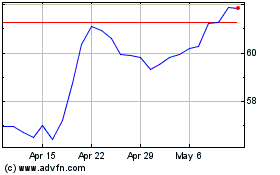If made New York Fed boss, Williams would probably continue
policies incumbent set
By Ryan Tracy
This article is being republished as part of our daily
reproduction of WSJ.com articles that also appeared in the U.S.
print edition of The Wall Street Journal (March 29, 2018).
The front-runner for president of the Federal Reserve Bank of
New York has a regulatory record similar to its current leader,
suggesting his appointment would bring continuity in the
regulator's relationship to Wall Street.
John Williams, the Federal Reserve Bank of San Francisco
president in line for a transfer to New York, and current New York
Fed President William Dudley have both supported restrictions on
banks imposed after the 2008 bailouts, criticized bank executives
for risk-management failures, and sought to put distance between
their staffs and the bankers they oversee.
They also have seen major bank misbehavior occur on their watch.
Mr. Williams's role in overseeing Wells Fargo & Co. triggered
criticism of his regulatory record because of the California-based
bank's risk-management failures and customer abuses.
When the Fed hit Wells Fargo with an unprecedented enforcement
action this year, it was both a rebuke of the firm and an
acknowledgment that regulators had allowed risk-management
deficiencies to fester.
As San Francisco Fed President, Mr. Williams oversees teams of
bank examiners responsible for firms including Wells Fargo. In a
March 2017 Wall Street Journal interview, he said the bank's
phony-accounts scandal, fueled by a sales culture heavily focused
on getting customers to sign up for more services, showed the bank
had broad problems that many observers missed.
"Supervision is not just, again, about stress tests and capital,
but it's also about the management, the governance, and culture,"
he said. "Clearly in the Wells Fargo case, the culture was part of
the problem. What's striking, of course, is Wells Fargo is
well-known to, thought to, have had a very strong culture."
The Fed's governing board in Washington writes bank rules and
signs off on major decisions involving individual firms. The Fed's
12 regional reserve banks across the country enforce the rules for
private-sector banks in their area. The New York Fed is especially
powerful given New York's outsize importance in finance.
The Fed also shares regulatory responsibility with other U.S.
agencies. San Francisco Fed examiners watch Wells Fargo's holding
company, while the Office of the Comptroller of the Currency
examines the firm's taxpayer-insured bank and the Consumer
Financial Protection Bureau audits its retail businesses. All three
were caught off guard in recent years by the extent of Wells
Fargo's problems.
The San Francisco Fed is currently relocating its bank
examiners' primary workspace, moving them from posts inside big
banks to regulatory offices, a spokesman said recently. That
follows a similar action Mr. Dudley took amid criticism that New
York Fed examiners were "captured" by bankers they oversee.
Here are some other things Mr. Williams has said about
regulatory policy.
On Postcrisis Regulations
Mr. Williams in August 2017 praised strict rules on big banks,
while also saying that rules on small and medium-size banks were
too strict. Mr. Dudley and other Fed officials have made similar
statements.
"We really need to make sure that the largest banks have lots of
capital, lots of liquidity," he said. "You don't need to have this
huge burden on smaller banks."
On Bank Culture
Mr. Dudley has said Wall Street firms need to change their
culture, pointing to market manipulation and other scandals.
Bankers, he has said, need to make sure their employees don't have
incentives to take excessive risks.
Mr. Williams in the March 2017 interview expressed a similar
view. "What we've learned over and over again is when the
incentives are just so skewed, [that is going to] have a negative
effect on culture and have negative consequences," he said.
On the Regulation of Financial Technology
"It's not that regulators are here to call the cops on the
party; we're here to make sure no one jumps off the roof," Mr.
Williams said in a 2016 speech about the benefits and pitfalls of
financial innovation. "It's important that we have a level playing
field, regardless of how institutions prefer to describe themselves
or what kind of charter they hold. As a matter of principle, if it
walks like a duck and quacks like a duck, it should be regulated
like a duck."
On the Fed's Role in Keeping the Financial System Stable
Mr. Williams said in 2015 the Fed should use monetary policy to
stabilize the financial system only as a last resort, after first
trying regulatory measures. He pointed to U.S. regulators'
crackdown on leveraged loans to heavily indebted companies as an
example of how regulators should address financial-stability
risks.
"We should instead supplant the focus on individual
institutions' financial soundness, based on traditional measures of
regulatory capital, with a more systemic view of the financial
system's overall health," he said.
Write to Ryan Tracy at ryan.tracy@wsj.com
(END) Dow Jones Newswires
March 29, 2018 02:47 ET (06:47 GMT)
Copyright (c) 2018 Dow Jones & Company, Inc.
Wells Fargo (NYSE:WFC)
Historical Stock Chart
From Mar 2024 to Apr 2024

Wells Fargo (NYSE:WFC)
Historical Stock Chart
From Apr 2023 to Apr 2024
